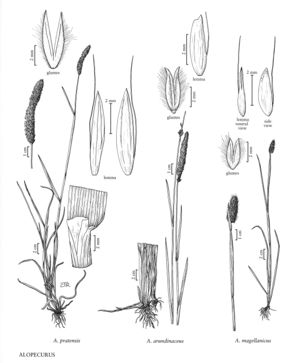Difference between revisions of "Alopecurus arundinaceus"
FNA>Volume Importer |
imported>Volume Importer |
||
| (7 intermediate revisions by 2 users not shown) | |||
| Line 4: | Line 4: | ||
|publications= | |publications= | ||
|common_names=Creeping meadow foxtail;Vulpin roseau | |common_names=Creeping meadow foxtail;Vulpin roseau | ||
| + | |special_status={{Treatment/ID/Special_status | ||
| + | |code=I | ||
| + | |label=Introduced | ||
| + | }} | ||
|basionyms= | |basionyms= | ||
|synonyms={{Treatment/ID/Synonym | |synonyms={{Treatment/ID/Synonym | ||
|name=Alopecurus ventricosus | |name=Alopecurus ventricosus | ||
| − | |authority= | + | |authority= |
| + | |rank=species | ||
}} | }} | ||
|hierarchy=Poaceae;Poaceae subfam. Pooideae;Poaceae tribe Poeae;Alopecurus;Alopecurus arundinaceus | |hierarchy=Poaceae;Poaceae subfam. Pooideae;Poaceae tribe Poeae;Alopecurus;Alopecurus arundinaceus | ||
| Line 19: | Line 24: | ||
-->{{Treatment/Body | -->{{Treatment/Body | ||
| − | |distribution=Colo.;Wash.;N.Dak.;Ariz.;Utah;Nebr.;Alta.;Man.;Nfld. | + | |distribution=Colo.;Wash.;N.Dak.;Ariz.;Utah;Nebr.;Alta.;Man.;Nfld. and Labr. (Labr.);N.W.T.;Mont.;Wyo.;Ky.;Idaho;S.Dak. |
|discussion=<p><i>Alopecurus arundinaceus</i> is native to Eurasia, extending north of the Arctic Circle and south to the Mediterranean. It grows in wet, moderately acid to moderately alkaline soils, on flood plains, near vernal ponds, and along rivers, streams, bogs, potholes, and sloughs. It was introduced for pasture in North Dakota and now occurs more widely, having been promoted as a forage species. It is sometimes used in seed mixtures for revegetation projects. It was evaluated for revegetation in Alberta, but there is no evidence that it was ever actually used in that province. <i>Alopecurus arundinaceus</i> suppresses <i>Hordeum jubatum</i>, a trouble¬some, unpalatable, weedy species, in irrigated pastures (Moyer and Boswall 2002).</p> | |discussion=<p><i>Alopecurus arundinaceus</i> is native to Eurasia, extending north of the Arctic Circle and south to the Mediterranean. It grows in wet, moderately acid to moderately alkaline soils, on flood plains, near vernal ponds, and along rivers, streams, bogs, potholes, and sloughs. It was introduced for pasture in North Dakota and now occurs more widely, having been promoted as a forage species. It is sometimes used in seed mixtures for revegetation projects. It was evaluated for revegetation in Alberta, but there is no evidence that it was ever actually used in that province. <i>Alopecurus arundinaceus</i> suppresses <i>Hordeum jubatum</i>, a trouble¬some, unpalatable, weedy species, in irrigated pastures (Moyer and Boswall 2002).</p> | ||
|tables= | |tables= | ||
| Line 29: | Line 34: | ||
-->{{#Taxon: | -->{{#Taxon: | ||
name=Alopecurus arundinaceus | name=Alopecurus arundinaceus | ||
| − | |||
|authority=Poir. | |authority=Poir. | ||
|rank=species | |rank=species | ||
| Line 36: | Line 40: | ||
|basionyms= | |basionyms= | ||
|family=Poaceae | |family=Poaceae | ||
| − | |distribution=Colo.;Wash.;N.Dak.;Ariz.;Utah;Nebr.;Alta.;Man.;Nfld. | + | |illustrator=Cindy Roché |
| + | |illustration copyright=Utah State University | ||
| + | |distribution=Colo.;Wash.;N.Dak.;Ariz.;Utah;Nebr.;Alta.;Man.;Nfld. and Labr. (Labr.);N.W.T.;Mont.;Wyo.;Ky.;Idaho;S.Dak. | ||
|reference=None | |reference=None | ||
|publication title= | |publication title= | ||
|publication year= | |publication year= | ||
| − | |special status= | + | |special status=Introduced |
| − | |source xml=https:// | + | |source xml=https://bitbucket.org/aafc-mbb/fna-data-curation/src/200273ad09963decb8fc72550212de541d86569d/coarse_grained_fna_xml/V24/V24_1112.xml |
|subfamily=Poaceae subfam. Pooideae | |subfamily=Poaceae subfam. Pooideae | ||
|tribe=Poaceae tribe Poeae | |tribe=Poaceae tribe Poeae | ||
Latest revision as of 16:22, 11 May 2021
Plants short-lived perennials; rhizomatous. Culms 30-110 cm, erect. Ligules 1.3-5 mm, truncate; blades 6-40 cm long, 3-12 mm wide; upper sheaths somewhat inflated. Panicles 3-10 cm long, 7-13 mm wide. Glumes 3.6-5 mm, connate in the lower 1/5-1/3, membranous, sparsely pubescent, keels not winged, ciliate, apices acute, divergent, pale green to lead-gray; lemmas 3.1-4.5 mm, connate in at least the lower 1/3, usually glabrous, sometimes with scattered hairs near the apices, apices truncate to obtuse, awns 1.5-7.5 mm, geniculate, exceeding the lemmas by 0-3 mm; anthers 2.2-3.5 mm. 2n = 26, 28, 30.
Distribution
Colo., Wash., N.Dak., Ariz., Utah, Nebr., Alta., Man., Nfld. and Labr. (Labr.), N.W.T., Mont., Wyo., Ky., Idaho, S.Dak.
Discussion
Alopecurus arundinaceus is native to Eurasia, extending north of the Arctic Circle and south to the Mediterranean. It grows in wet, moderately acid to moderately alkaline soils, on flood plains, near vernal ponds, and along rivers, streams, bogs, potholes, and sloughs. It was introduced for pasture in North Dakota and now occurs more widely, having been promoted as a forage species. It is sometimes used in seed mixtures for revegetation projects. It was evaluated for revegetation in Alberta, but there is no evidence that it was ever actually used in that province. Alopecurus arundinaceus suppresses Hordeum jubatum, a trouble¬some, unpalatable, weedy species, in irrigated pastures (Moyer and Boswall 2002).
Selected References
None.
